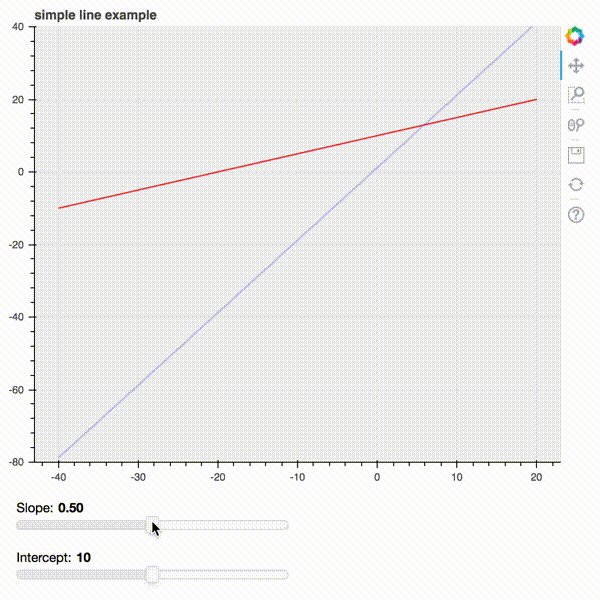У меня нет Jupyter Notebook, поэтому эти 2 примера являются чисто приложениями Bokeh, первый использует обратный вызов JS, а второй - обратный вызов Python (Bokeh v1.0.4).
import numpy as np
from bokeh.plotting import figure, show
from bokeh.models import ColumnDataSource, Slider, CustomJS, Range1d
from bokeh.layouts import column
slider_slope = Slider(start = 0, end = 1, value = 0.5, step = 0.1)
slider_intercept = Slider(start = 0, end = 20, value = 10, step = 1)
slider_code = ''' i = slider_intercept.value
s = slider_slope.value
x = r.data_source.data['x'];
y = [];
for (index = 0; index < x.length; index ++)
y.push((s * x[index]) + i);
r.data_source.data['y'] = y
r.data_source.change.emit(); '''
s = slider_slope.value # slope.
i = slider_intercept.value # intercept.
x = np.linspace(-40, 20, 200)
y = [(s * xx + i) for xx in x]
p = figure(title = "simple line example", plot_height = 500, plot_width = 600, y_range = Range1d(start = -80, end = 40), background_fill_color = '#efefef')
r = p.line(x, y, color = "red", line_width = 1.5, alpha = 0.8) # 1st line. This line can be controlled by sliders.
q = p.line(x, 2 * x + 1.2, color = "blue", line_width = 1.9, alpha = 0.2) # 2nd line.
slider_callback = CustomJS(args = dict(slider_slope = slider_slope,
slider_intercept = slider_intercept,
r = r), code = slider_code)
slider_slope.callback = slider_callback
slider_intercept.callback = slider_callback
layout = column(p, slider_slope, slider_intercept)
show(layout, notebook_handle = True)
Вы можете легко перевести его в приложение сервера Bokeh с обратным вызовом Python:
import numpy as np
from bokeh.plotting import figure, show, curdoc
from bokeh.models import Slider, CustomJS
from bokeh.layouts import column
slider_slope = Slider(title = 'Slope', start = 0, end = 1, value = 0.5, step = 0.1)
slider_intercept = Slider(title = 'Intercept', start = 0, end = 20, value = 10, step = 1)
s = slider_slope.value # slope.
i = slider_intercept.value # intercept.
x = np.linspace(-40, 20, 200)
y = [(s * xx + i) for xx in x]
p = figure(title = "simple line example", plot_height = 500, plot_width = 600, y_range = Range1d(start = -80, end = 40), background_fill_color = '#efefef')
r = p.line(x, y, color = "red", line_width = 1.5, alpha = 0.8) # 1st line. This line can be controlled by sliders.
q = p.line(x, 2 * x + 1.2, color = "blue", line_width = 1.9, alpha = 0.2) # 2nd line.
def update(attr, old, new):
s = slider_slope.value # slope.
i = slider_intercept.value # intercept
x = r.data_source.data['x'];
y = []
for value in x:
y.append((s * value) + i)
r.data_source.data['y'] = y
slider_slope.on_change('value', update)
slider_intercept.on_change('value', update)
layout = column(p, slider_slope, slider_intercept)
curdoc().add_root(layout)
Результат:
